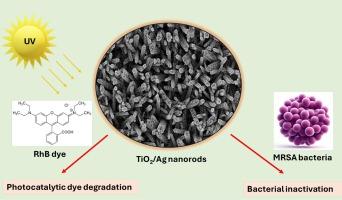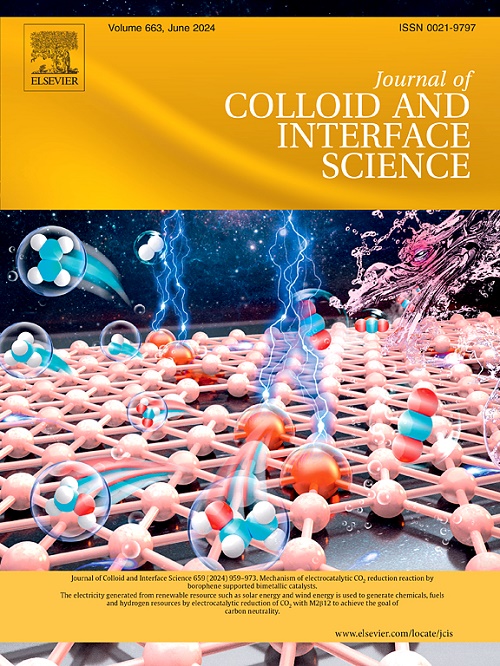在二氧化钛纳米棒阵列上沉积无电解银纳米粒子,增强光催化和抗菌性能。
IF 9.4
1区 化学
Q1 CHEMISTRY, PHYSICAL
引用次数: 0
摘要
假设:用于获得高表面积光催化剂的纳米颗粒尺寸较小,因此很难将其从溶液中去除。在基底上生产光催化剂可以缓解这一限制。在光催化剂中加入异质结,例如 TiO2/Ag,可以通过肖特基结的形成提高光催化性能,并引入抗菌特性:实验:通过水热法在基底上合成了二氧化钛纳米棒阵列,并使用无电解电镀技术在其上沉积了银纳米颗粒,沉积时间和金属前体浓度各不相同。通过监测罗丹明 B(RhB)在紫外线下的降解情况来评估光催化性能,并使用耐甲氧西林金黄色葡萄球菌测试薄膜的抗菌性能:银纳米粒子的含量受银沉积工艺的控制。TiO2/Ag 纳米棒阵列含有 6.6 原子%的 Ag(直径 ∼ 25 nm 的纳米颗粒),在 6 小时内降解了 88% 的 RhB,而在相同的反应条件下,裸 TiO2 纳米棒的降解率为 54%。异质结形成后,光致发光减少,这表明电子从二氧化钛转移到了银纳米粒子中,从而减少了电荷载流子的重组。在黑暗中进行的抗菌测试表明,与 TiO2 纳米棒相比,TiO2/Ag 样品在暴露 16 小时后对耐甲氧西林金黄色葡萄球菌的抗菌性能更强,死亡率达 84%。本文章由计算机程序翻译,如有差异,请以英文原文为准。

Electroless Ag nanoparticle deposition on TiO2 nanorod arrays, enhancing photocatalytic and antibacterial properties
Hypothesis: The small size of the nanoparticles used to obtain high surface area photocatalysts makes their removal from solution difficult. Producing photocatalysts on substrates would alleviate this limitation. Adding heterojunctions to photocatalysts, for example, TiO2/Ag, could improve photocatalytic performance due to Schottky junction formation and introduce antibacterial properties.
Experiments: TiO2 nanorod arrays were synthesised on a substrate via a hydrothermal approach, on which Ag nanoparticles were deposited using an electroless plating technique with varied deposition times and metal precursor concentrations. Photocatalytic performance was evaluated by monitoring Rhodamine B (RhB) degradation under ultraviolet light and antibacterial properties of the films tested using Methicillin-resistant Staphylococcus aureus.
Findings: The Ag nanoparticle content was controlled by the Ag deposition process. The TiO2/Ag nanorod array containing 6.6 atomic% Ag as nanoparticles of ∼ 25 nm in diameter degraded 88 % of the RhB in 6 h compared to 54 % degradation for bare TiO2 nanorods under the same reaction conditions. Decreased photoluminescence with heterojunction formation would indicate electron transfer from the TiO2 into the Ag nanoparticles, thereby reducing charge carrier recombination. The antibacterial test conducted in the dark revealed enhanced performance for the TiO2/Ag sample compared to TiO2 nanorods against Methicillin-resistant Staphylococcus aureus after 16 h exposure with a death rate of 84 %.
求助全文
通过发布文献求助,成功后即可免费获取论文全文。
去求助
来源期刊
CiteScore
16.10
自引率
7.10%
发文量
2568
审稿时长
2 months
期刊介绍:
The Journal of Colloid and Interface Science publishes original research findings on the fundamental principles of colloid and interface science, as well as innovative applications in various fields. The criteria for publication include impact, quality, novelty, and originality.
Emphasis:
The journal emphasizes fundamental scientific innovation within the following categories:
A.Colloidal Materials and Nanomaterials
B.Soft Colloidal and Self-Assembly Systems
C.Adsorption, Catalysis, and Electrochemistry
D.Interfacial Processes, Capillarity, and Wetting
E.Biomaterials and Nanomedicine
F.Energy Conversion and Storage, and Environmental Technologies

 求助内容:
求助内容: 应助结果提醒方式:
应助结果提醒方式:


